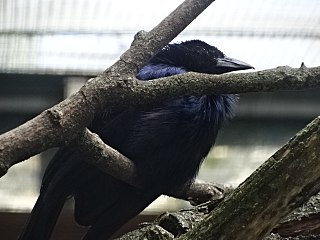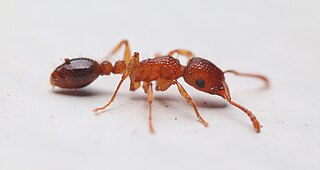
Tetramorium atratulum is a rare workerless socially parasitic ant from the Palaearctic region, which has even been introduced together with its host in North America. This extreme inquiline is represented only by female and pupoid type male individuals, whose morphology and anatomy indicate a highly specialized level of parasitism. The body of males is depigmentated, the cuticle is thin, the petiole and postpetiole are widely connected, and degenerate mandibles, palps, and antennae are observed. Female wing venation is reduced and the occipital region is narrowed. Mature females are typically physogastric and found in queenless host nests.

The striated swallow is a species of swallow found in open, often hilly, areas with clearings and cultivation across Southeast Asia to northeastern India and Taiwan.

The trumpet manucode is a species of bird in the family Paradisaeidae.

The hooded mannikin or hooded munia, also known as the New Britain mannikin or Sclater's mannikin, is a species of estrildid finch found in New Britain and New Guinea.
Mayr's forest rail is a species of bird in the family Sarothruridae. It is found in northern New Guinea.
Mayr's honeyeater is a species of bird in the family Meliphagidae. It is found in Indonesia and Papua New Guinea. Its natural habitat is subtropical or tropical moist montane forests.
Tetramorium schmitzi is a species of ant in the genus Tetramorium. It is endemic to Israel.
Tetramorium kutteri is a species of ant in the genus Tetramorium. It is endemic to Spain.

Tetramorium inquilinum is an ectoparasitic ant found in Europe. It was discovered by Swiss myrmecologist Heinrich Kutter. The species is unusual for lacking a worker caste, the queens and males living entirely off the care of the pavement ant. It has been called "the 'ultimate' parasitic ant" by myrmecologists Edward O. Wilson and Bert Hölldobler.
Tetramorium microgyna is a species of ant in the genus Tetramorium. It is found in South Africa and Zimbabwe.

Tetramorium is a genus of ants in the subfamily Myrmicinae that includes more than 520 species. These ants are also known as pavement ants.
Tetramorium parasiticum is a species of ant in the genus Tetramorium. It is endemic to South Africa.

Tetramorium caespitum, also known as the pavement ant, is a species of ant in the family Formicidae.

Tetramorium bicarinatum, is a species of ant of the family Formicidae in the order Hymenoptera that originated in South East Asia.

Aphaenogaster mayri is an extinct species of ant in formicid subfamily Myrmicinae known from a series of Late Eocene fossils found in North America. A. mayri was one of two Aphaenogaster species described in a 1930 paper by Frank M. Carpenter.

Tetramorium nazgul is a species of Myrmicine ant native to Analalava, Ambohijanahary, and the Zombitse-Vohibasia National Park, Madagascar. The species is characterized by long, thin, propodeal spines. Its body is covered in a multitude of long hairs. General coloration is dark brown or black, with lighter coloration on the legs. The species is commonly found in leaf litter in tropical dry forests and montane rainforests, typically around elevations of 700 to 1,100 meters. It was named after the Nazgûl from J. R. R. Tolkien's The Lord of the Rings.

The Wondiwoi tree-kangaroo is a critically endangered, bear-like mammal native to tropical mountain forests on the island of New Guinea. Elusive and rare, it was considered extinct until rediscovery in 2018. It is a species of tree-kangaroo, a group of long-tailed, bear-like animals native to Australia and New Guinea that mostly live in trees and feed on plant matter. Tree-kangaroos belong to the macropod family (Macropodidae) with kangaroos, and carry their young in a pouch like most other marsupials. The Wondiwoi tree-kangaroo is likely threatened by hunting, and is known only from remote mountains on the Wondiwoi Peninsula in northwest New Guinea.











